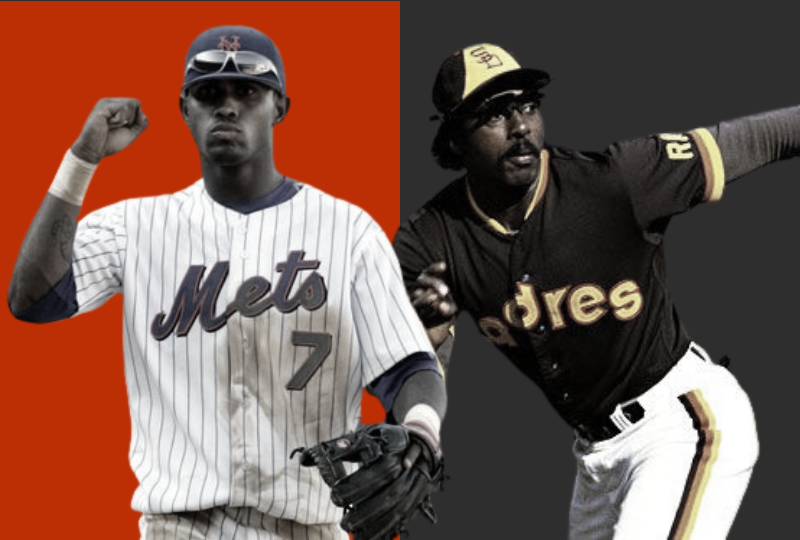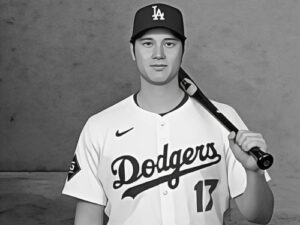Is time travel possible? Is reincarnation real? Why do some people think they’ve lived before, at some distant time, with memories of a prior life?
Why do some baseball players have such uncanny similarities? This is why we’re starting a series of articles called Time Twins. In this series, we’ll examine a set of baseball players who have so many things in common, it’s eerie.
We start with a pair of shortstops, both switch-hitters who became All-Stars in the National League for NL East teams. Both had excellent promise with amazing ability as ballplayers. Yet, both of these infielders fell short of expectations. Even though they both had very good careers.
Let’s look at José Reyes and Garry Templeton.
José Reyes: The Greatest Shortstop in the History of the Mets
The Mets first became enamored with José Reyes when he was just 15. A scout saw the skinny ballplayer scooping up ground balls on a dusty infield in Santiago, and made a note. When Reyes turned 16, the team quickly signed him to a pro contract. At that time, Reyes was already tinkering with switch-hitting, and the first scouting report submitted for the young player stated that his throwing arm was already “major league caliber.”
Almost immediately upon his arrival in the U.S., Reyes was an exceptional player who distanced himself from his peers. In his first two full pro seasons, he batted .301, stole 88 bases, and hit 34 triples. He had yet to turn 20 years old.
Reyes followed in the footsteps of previous shortstops from the Dominican Republic who became stars in the United States and Major League Baseball, like Julio Franco, Tony Fernández, and Miguel Tejada.
20-year old Reyes burst onto the MLB scene in 2003 as a member of the New York Mets, showcasing a blend of speed and skill that immediately captured the attention of fans and opponents alike. With a sprinter’s acceleration, he became one of the most exciting players to watch, routinely turning routine ground balls into infield singles and transforming routine singles into electrifying doubles with his daring baserunning. He hit .307 in 69 games as a rookie. He never again had to audition for the shortstop job with the Mets.
Known for his vibrant personality and infectious energy, Reyes quickly became a fan favorite in New York. The “Reyes Run,” a term coined to describe his base-to-base exploits, became a common phrase among Mets enthusiasts. Beyond his speed, Reyes displayed defensive prowess at shortstop, showcasing exceptional range and a strong arm that made him a cornerstone of the Mets’ infield.
In 2005, his first full season in MLB, Reyes led the league with 60 steals, had a league-high 17 triples, scored 99 runs, smacked 190 hits, and played all but one game.
In 2006, Reyes enjoyed a fine season, earning his first and only Silver Slugger Award. He led the National League in triples and stolen bases (with 64). As the catalyst for the Mets, Reyes played a pivotal role in their journey to the National League Championship Series, solidifying his status as one of the premier shortstops in the league.
From 2005 to 2008, Reyes accumulated at least 190 hits every season, and and earned MVP votes each season. In 2006 he finished seventh in balloting.
Reyes continued to make a significant impact over the years with New York, earning four All-Star selections and receiving recognition for his offensive and defensive contributions. His versatility allowed him to adapt to different roles within the lineup, showcasing his ability to hit for average, power, and steal bases at an elite level.
In 2011, in his walk year, Reyes won the NL batting crown with a .337 mark, while once again pacing the league in triples, with 16. That season was unquestionably his best, as he posted a 144 OPS. But, during the offseason he signed as a free agent with the Miami Marlins, severing his ties with the organization that had signed him as an amateur free agent when he was 16 years old.
However, Reyes faced challenges as well. In 2011, he dealt with injuries that affected his performance on the field. Despite these setbacks, he remained resilient and continued to contribute when healthy. After leaving the Mets in 2011, Reyes had stints with the Miami Marlins, Toronto Blue Jays, and Colorado Rockies, experiencing different facets of the league and adding valuable experience to his career.
Gruff Garry: Baseball’s Best Switch-Hitting Shortstop
Satchel Paige was nearing his 80th birthday (apparently) when he observed Garry Templeton. “That’s the best shortstop I’ve ever seen,” the old negro leaguer said. This was when Templeton was with the Cardinals in the late 1970s. Paige had played briefly with Templeton’s father, Spiavia in the negro leagues. Garry never knew his dad had been a pro ballplayer until he was a teenager.
In the 1979 season, Templeton achieved career-high offensive numbers, batting an impressive .314 with 211 hits, 32 doubles, and an NL-best 19 triples. His ability to consistently make contact and find gaps in the defense made him a valuable asset in the Cardinals’ lineup. Templeton’s offensive contributions were complemented by his speed on the basepaths, as he swiped 26 bases that season.
From 1977-1980 for St. Louis, Templeton averaged 188 hits, 88 runs scored, 25 doubles, 15 triples, 30 stolen bases, and batted .308. In 1977 he finished 13th in NL Most Valuable Player voting.
Templeton was lean but muscular, with long legs and the most powerful and accurate throwing arm of any shortstop in his league. He ran like an Olympian: he was an all-state athlete in California in track, basketball, and football. In his teenage years, baseball was his fourth-best sport. His first five years were better than 95 percent of the shortstops in the Hall of Fame, but Templeton regressed after he was traded to the San Diego Padres. A series of knee injuries was mostly responsible, as well as a broken thumb. He was still an above average defensive player, but San Diego’s grass field was a death blow to his offensive game. Gone were the temper tantrums and moodiness, but also gone were the triples and 20 Astroturf-aided hits per season.
Comparing Reyes and Templeton
Both José Reyes and Garry Templeton were switch-hitting shortstops with speed and a strong arm. Both were good base stealers and both led the National League in triples a number of times, Templeton three straight years and Reyes four times overall. Both established themselves as stars in their early 20s. Each had a knack for controversy, often because of their mouth. When Templeton learned he was selected as a substitute for the All-Star Game, he refused to go. He famously said (or agreed to the statement): “If I ain’t startin’, I ain’t departin’.” When Reyes was told his manager was considering moving him from the leadoff spot, he bristled: “I’ve hit there all my life, I won’t hit anywhere else.” But that’s where the similarities end.
Unlike Templeton, Reyes was an outgoing (almost bubbly) man known for being loose and lively in the clubhouse. He was criticized for an elaborate dance he liked to do after hitting a home run. He was a little too happy when his team lost, according to some teammates. But Reyes was a fun guy for the most part, a smile on his face in the batting cage. Templeton was a dour man who never really loved playing baseball. It was his job and he didn’t care for the extra stuff that came with being a ballplayer outside the white lines. In 1980, after Templeton made obscene gestures to fans in St. Louis, he was suspended and spent time in a psychiatric hospital to deal with his rage.
Templeton and Reyes diverge in regards to productivity as well. Reyes kept being a valuable ballplayer after his 26th birthday, while Templeton took a few steps backward after a trade to San Diego and survived the rest of his career on his defensive talent while stagnating at the plate.
Reyes is clearly the best shortstop in the history of the New York Mets, finishing with more than 1,500 hits, 100 homers, and 400 stolen bases with the team. For decades the Mets had a problem finding a great third baseman, until David Wright solved that. But the franchise also had troubles at short, usually settling on good-field, no-hit guys until Reyes came along.
Templeton is probably the best shortstop to make the Padres his team for many years. Ozzie Smith only wore the brown and gold four seasons.






